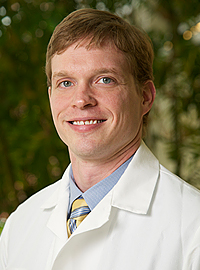The Link Between Dysplastic Squamous Cells and Merkel Cell Carcinoma (MCC)
By Camren Clouthier | October 15 2021Merkel cell carcinoma (MCC) is one of the most deadly skin cancers. A team including Drs. Paul Harms, Aaron Udager, May Chan, Rajiv Patel, and Andrzej Dlugosz applied genomics to reveal a surprising possible origin for some MCC tumors: dysplastic squamous cells in the overlying epidermis. Despite profound differences in appearance and clinical behavior, the two cell populations share important mutations. The team then used a newly available whole slide imaging platform to quantitate the immunophenotypic switch from squamous cells to MCC at single-cell resolution. Their findings are reported in Modern Pathology.
"Can small cell neuroendocrine carcinoma arise from squamous dysplasia?", asks Dr. Harms.
 As experts first observed, MCC is an aggressive cutaneous neuroendocrine carcinoma, that classically presents as a rapidly growing nodule on the sun-exposed skin of older individuals. This presents a significant risk of metastatic disease, and an estimated 33–46% historic rate of mortality. Surgery and radiotherapy are traditional mainstays of treatment. Immunotherapy can also be especially effective for advanced diseases. However, research indicates that a significant fraction of patients will progress on immunotherapy, thus highlighting the need for improved biological understanding and targeted therapies for this type of malignancy.
As experts first observed, MCC is an aggressive cutaneous neuroendocrine carcinoma, that classically presents as a rapidly growing nodule on the sun-exposed skin of older individuals. This presents a significant risk of metastatic disease, and an estimated 33–46% historic rate of mortality. Surgery and radiotherapy are traditional mainstays of treatment. Immunotherapy can also be especially effective for advanced diseases. However, research indicates that a significant fraction of patients will progress on immunotherapy, thus highlighting the need for improved biological understanding and targeted therapies for this type of malignancy.
On the other hand, in contrast to MCC, cutaneous squamous cell carcinoma (SCC) displays a relatively low propensity for metastasis, and has been associated with dysplastic keratinocytic precursor lesions in the epidermis. Unlike MCC, RB1 mutation is rare in cutaneous invasive SCC, although a subset of SCCIS harbors RB1 mutations.
After compiling this data, researchers then compared 7 cases of MCC-associated SCCIS to the matched MCC tumors, using a focused next-generation sequencing (NGS) cancer panel optimized for sensitive detection of mutations and chromosomal copy number variations in small samples. In 6 of 7 cases, we found shared TP53 and/or RB1 mutations between MCC and SCCIS pairs. The 7th sample demonstrated clonal relatedness between SCCIS and spindle cell SCC, but not the adjacent MCC.

Gene expression profiling later revealed that MCC-associated SCCIS was associated with an intermediate transcriptional profile between MCC and conventional SCCIS, with the expression of both epidermal and Merkel cell genes. Transcriptome data and immunohistochemistry demonstrated that the squamous-neuroendocrine shift correlated with a decrease in the Polycomb epigenetic mark H3K27 trimethylation (H3K27Me3), loss of Rb1 protein expression, and downregulation of HLA-A. The findings also suggest, in rare cases, cutaneous SCCIS undergoes a shift to a neuroendocrine MCC phenotype accompanied by epigenetic and transcriptional changes, probable decreased immune surveillance, and an aggressive phenotype.
Ultimately, the study significantly expands upon previous studies which have examined the relationship between MCC and SCC. A larger study of combined MCC tumors compared the matched neuroendocrine and squamous components in two of the tumors and demonstrated similarity in patterns of copy number alteration and gene-level mutations between the components.
"Rigorous statistical comparisons of nucleotide-level genomic similarity between the components were not performed to exclude the possibility of coincidental overlap," explains Harms.
Dermal squamous differentiation in combined tumors might represent squamous metaplasia. In contrast, clinicians evaluated SCCIS, which is substantially more likely to represent a precursor lesion.
—
The full publication in Modern Pathology is here.
 ON THE COVER
ON THE COVER
 ON THE COVER
ON THE COVER
 ON THE COVER
ON THE COVER
 ON THE COVER
ON THE COVER
 ON THE COVER
ON THE COVER
 ON THE COVER
ON THE COVER
 ON THE COVER
ON THE COVER
 ON THE COVER
ON THE COVER
 ON THE COVER
ON THE COVER
 ON THE COVER
ON THE COVER
